9 Crucial Steps After Buying Ring Insurance: Coverage, Valuation & More

After Buying Ring Insurance. When you purchase an exquisite piece of jewelry, such as a diamond ring, it’s not just an investment in beauty and style – it’s an investment in a cherished memory and a symbol of love and commitment. However, like any valuable possession, it’s essential to protect your ring from the unexpected. That’s where ring insurance comes into play. But getting ring insurance is just the first step; there are several crucial steps to take after securing coverage to ensure your investment remains safeguarded and your peace of mind remains intact.
1. Thoroughly Review Your Coverage
Once you’ve obtained ring insurance, take the time to carefully review the policy documents. Understand the coverage limits, deductibles, and exclusions. Ensure that the coverage limit is sufficient to protect the full value of your ring, and consider negotiating for a higher limit if necessary. Pay close attention to any conditions or restrictions that could potentially void your coverage, such as failing to have your ring professionally cleaned or appraised on a regular basis.
2. Understand the Valuation Process
Periodic jewelry valuation is crucial for maintaining adequate insurance coverage. As the value of precious metals and gemstones fluctuates over time, your ring’s worth may increase or decrease. Work closely with a reputable and certified jeweler or appraiser to ensure your ring is accurately valued at regular intervals. This will help you adjust your coverage limits accordingly and avoid being underinsured or paying for unnecessary overage.
- Experts recommend having your ring appraised every two to three years or whenever significant life events occur, such as a move, marriage, or inheritance.
- Keep detailed documentation of your ring’s description, including the metal type, gemstone specifications, and any unique characteristics or engravings.
- Store appraisal documents, receipts, and photographs of your ring in a secure location, such as a fireproof safe or a safety deposit box.
3. Consider Artisan-Made Rings
If you’ve invested in a one-of-a-kind, artisan-made ring, you may need to take additional steps to ensure proper coverage. Many standard insurance policies may not fully account for the unique craftsmanship and materials used in these pieces. Work closely with your insurance provider to understand their requirements for insuring custom or artisan jewelry, which may include providing detailed documentation, additional appraisals, or higher premiums.
4. Explore Adjustable Deductible Plans
Many insurance providers offer adjustable deductible plans, which allow you to choose a higher or lower deductible based on your risk tolerance and budget. A lower deductible typically means higher premiums but less out-of-pocket expense if you need to file a claim. Conversely, a higher deductible can lower your premiums but requires a more significant upfront cost if you need to replace your ring.
- Carefully weigh the pros and cons of different deductible options to find the right balance for your needs and financial situation.
- Consider raising your deductible if you’re willing to assume more risk in exchange for lower premiums, or lower your deductible if you prioritize minimizing out-of-pocket expenses in the event of a claim.
5. Conduct an In-Depth Quote Analysis
Before finalizing your ring insurance policy, take the time to conduct an in-depth analysis of multiple quotes from different providers. Compare coverage limits, deductibles, premiums, and any additional riders or endorsements offered. Don’t simply choose the cheapest option; instead, focus on finding a comprehensive policy that provides the protection you need at a reasonable cost.
- Look for reputable insurers with a strong financial rating and a history of reliable claims handling.
- Consider bundling your ring insurance with other policies, such as homeowners or renters insurance, to potentially qualify for discounts.
- Read customer reviews and seek recommendations from trusted sources, such as your jeweler or financial advisor.
6. Implement Preventative Measures
While insurance provides financial protection, it’s equally important to take preventative measures to reduce the risk of loss or damage to your ring. Follow these best practices:
- Have your ring professionally inspected and cleaned at least once a year to ensure the settings are secure and the metal and gemstones are in good condition.
- Remove your ring when engaging in activities that could potentially damage it, such as household chores, sports, or manual labor.
- Store your ring in a secure location, such as a safe or lockbox, when not wearing it.
- Consider having your ring insured for an agreed value, which means the insurance company will pay the full insured amount in the event of a total loss, without factoring in depreciation.
7. Stay Vigilant and Report Promptly
In the unfortunate event that your ring is lost, stolen, or damaged, it’s crucial to act promptly. Notify your insurance provider as soon as possible, following their specific claims procedures. Provide detailed information about the circumstances surrounding the incident, including dates, locations, and any supporting documentation or police reports.
- Be prepared to provide a detailed description of your ring, including any identifying characteristics, to aid in the claims process.
- Keep thorough records of all communications with your insurance provider, including dates, contact names, and any instructions or commitments made.
- If your ring is damaged, avoid further wear or repair attempts until the insurance company has inspected and approved the claim.
8. Consider Additional Coverage
Depending on your lifestyle and the value of your ring, you may want to consider additional coverage options beyond a standard ring insurance policy. These could include:
- Travel insurance: Provides protection for your ring while traveling, covering loss, theft, or damage during trips.
- Scheduled personal property endorsement: Adds extra coverage for high-value items, such as fine jewelry, to your homeowners or renters insurance policy.
- Mysterious disappearance coverage: Provides protection in the event your ring vanishes without explanation, which may not be covered under standard policies.
9. Stay Informed and Reevaluate Regularly
The insurance landscape is constantly evolving, with new products, policies, and regulations emerging regularly. Stay informed about changes in the industry that could impact your coverage or provide new opportunities for better protection. Additionally, reevaluate your ring insurance policy periodically to ensure it continues to meet your needs as your circumstances or the value of your ring changes over time.
By following these crucial steps after buying ring insurance, you can safeguard your precious investment and enjoy the beauty and significance of your ring with complete peace of mind. Remember, a well-protected ring is not just a symbol of love; it’s a testament to your commitment to preserving cherished memories for generations to come.











